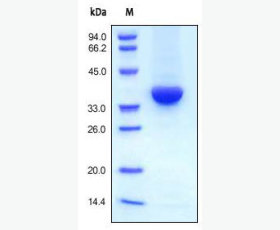Recombinant Human Protein Phosphatase 1G/PP1MG
| Product name: | Recombinant Human Protein Phosphatase 1G/PP1MG |
| Source: | E.coli |
| Purity: | Greater than 95% as determined by reducing SDS-PAGE. |
| Buffer Formulation: | Supplied as a 0.2 μm filtered solution of 25mM TrisHCl, 1mM DTT, 1mM EDTA, 2mM β-ME, 20% Glycerol, pH 7.5. |
| Applications: | Applications:SDS-PAGE; WB; ELISA; IP. |
| Storage: | Avoid repeated freeze/thaw cycles. Store at 2-8 oC for one month. Aliquot and store at -80 oC for 12 months. |
| UOM: | 100ug/50ug/200ug/1mg/1g |
| Source | E.coli |
| Description | Recombinant Human PP1MG is produced by our E.coli expression system and the target gene encoding Met317-Asp546 is expressed with a 6His tag at the C-terminus. |
| Names | Protein Phosphatase 1G, Protein Phosphatase 1C, Protein Phosphatase 2C Isoform Gamma, PP2C-Gamma, Protein Phosphatase Magnesium-Dependent 1 Gamma, PPM1G, PPM1C |
| Accession # | O15355 |
| Formulation | Supplied as a 0.2 μm filtered solution of 25mM TrisHCl, 1mM DTT, 1mM EDTA, 2mM β-ME, 20% Glycerol, pH 7.5. |
| Shipping |
The product is shipped on dry ice/ice packs. |
| Storage |
Store at < -20°C, stable for 6 months after receipt. Please minimize freeze-thaw cycles. |
| Purity |
Greater than 95% as determined by reducing SDS-PAGE. |
| Endotoxin | Less than 0.1 ng/µg (1 IEU/µg) as determined by LAL test. |
| Amino Acid Sequence |
MEGKEEPGSDSGTTAVVALIRGKQLIVANAGDSRCVVSEAGKALDMSYDHKPEDEVELARIKNAG GKVTMDGRVNGGLNLSRAIGDHFYKRNKNLPPEEQMISALPDIKVLTLTDDHEFMVIACDGIWNV MSSQEVVDFIQSKISQRDENGELRLLSSIVEELLDQCLAPDTSGDGTGCDNMTCIIICFKPRNTA ELQPESGKRKLEEVLSTEGAEENGNSDKKKKAKRDLEHHHHHH
|
| Background | Protein Phosphatase 1G (PP1MG) is a cytoplasmic protein that belongs to the PP2C family. PPM1G is widely expressed; it is abundant in testis, skeletal muscle, and heart. PPM1G is a negative regulator of cell stress response pathways. PPM1G is responsible for the dephosphorylation of Pre-mRNA splicing factors, an important factor for the formation of functional spliceosome. PPM1G also plays a role in regulating cell cycle progression. |














